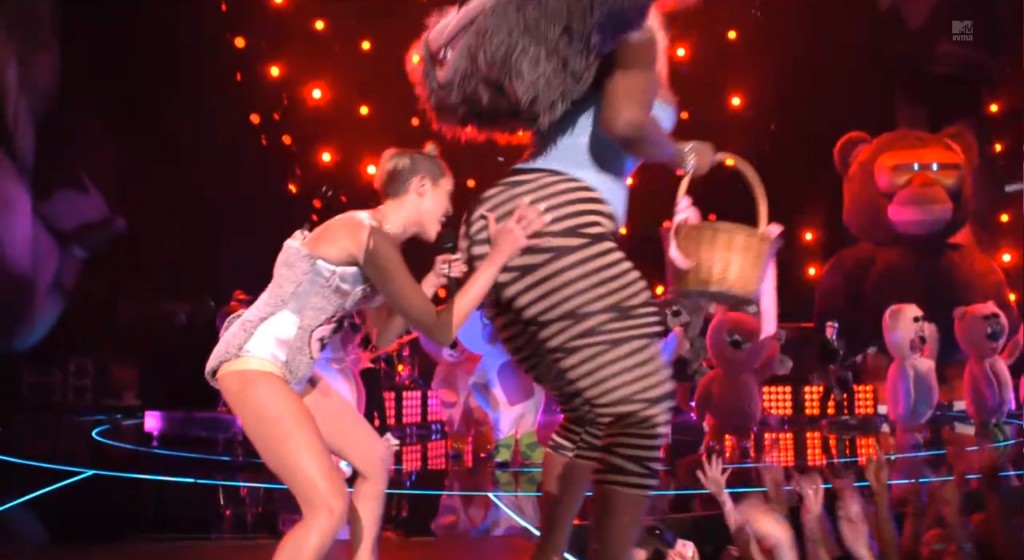By: Uzma Chowdhury and Rachael Zipperer
We know you are tired of this.
We know the VMAs were like three weeks ago.
We know that Syria is way more important, but, please, hear us out: there is something going on that is a lot bigger than Miley’s tongue or Robin Thicke’s Beetlejuice attire.
The fact is, the reactions to the Miley/Robin VMA performance have been more extreme and problematic than the performance itself…and for us that is the real social crisis.
In a recent article, a fellow GPR writer argued that the “public outcry” to the performance was “focused on the racy 20-year-old” when we should also be focusing on “the 36-year-old who danced behind her.”
And while we agree that yes, it is problematic that society focuses on Miley’s behavior, as a woman, when Robin was just as much a part of the act, we do not see anything wrong with the act itself. The most talked about moment of the performance was definitely racy, but it was a simply a performance and a consensual act between two adults.
We agree with our fellow GPR writer that the lyrics of Robin Thicke’s “Blurred Lines” trivialize rape and further contribute to the acceptance of harmful gender norms that demean women while empowering men. But we do not agree that the focus (read “blame”) of the dancing incident should be placed on Miley as well as Robin Thicke. We do not think either of them should be criticized for this display: to blame Robin Thicke is just as problematic as solely blaming Miley. Here is why:
1. By condemning Miley for what she wore and how she danced, society only perpetuates the problematic ideas of how women should behave.
2. By further blaming Robin Thicke for not being “freeing” we are identifying men as an authority on women.
Yes, there are “blurred lines” between gender norms, and yes, we should focus on these issues, but this specific performance is not an example. Cyrus and Thicke are consenting adults, they can do whatever they want. Calling Miley disrespectful because of the way she dressed and danced and by calling for a “stricter moral outcry” against Thicke “for parading around naked women,” the author of the article herself perpetuates gender norms. It is an oppressive gender norm to tell women they should not be promiscuous. It is an oppressive gender norm to place men in the position of control to take the “moral” high ground and determine what is best for a woman.
To say that Robin Thicke should be held accountable for Miley Cyrus’s actions is to say that he, as a man, should have control over her actions because she is a woman. The author also argues that though “Miley Cyrus’ outfit and performance can hardly be viewed as respectful towards herself or other women, perhaps we should hold Thicke more accountable for his actions, which were clearly not funny or the least bit freeing towards women.”
Condemning Miley’s outfit as disrespectful towards herself and other women is slut-shaming–a term used to describe the condemnation of a woman or girl for being sexual. And, indeed, perhaps “respect” is subjective, and perhaps the critics are not the best authority on whether or not Cyrus respects herself. The bottom line is: Miley Cyrus is and should be in control of what she does with her body. Neither we as the viewing public nor Robin Thicke as a man have the authority to tell her how to express her own sexuality. He did not parade her around. Both of these people chose to act in this manner. He’s just being Robin, she’s just being Miley, and that is OK.
However, we cannot very well publish this opinion condemning those that have taken issue with whether or not the performance was degrading toward women without discussing other ways in which the performance was problematic. Feminists, including us, may say Miley owning her sexuality and making her own choices as an adult female is in no way degrading women. In fact she may be empowering women to do what they want with their bodies without fear of being judged. The performance was not anti-feminist, but what it was, which has gone shockingly unnoticed by many of the outraged responses to it, is very much racist.
What does it say that we are all obsessed with the sexualization of two white people, without even considering the exclusively black back up dancers on stage? Perhaps we are all being distracted from a silent acceptance of “ratchet culture” that is far more sinister.
The responses to the performance have focused on the sexuality of Miley Cyrus, the responses have been either slut-shaming or feminists fighting shamers–and in all of this social media hullabaloo, a key aspect, a key victim of oppression has been left out. Not many of those who are outraged have discussed the performance in terms of how Miley Cyrus participated in cultural appropriation as “a wealthy white woman…taking elements from black culture in order to achieve a specific image…without having to deal with the racism and racialization that black women live with every day.” Miley Cyrus, once Hannah Montana, is trying so hard to become the opposite of the good, Disney girl she once was–and she is doing so by embracing “ratchet culture.”
Ratchet culture, described by Jody Rosen, is “the potent sexual symbolism of black female bodies.” Miley Cyrus uses black women in her performance and videos as props in this new ratchet re-branding scheme. She is “taking elements of black culture and using them to give her the patina of street cred that she wants so badly. She is playing at being black without even trying to understand what the lived experience of being black really is.”
There are few social repercussions for her as a result of doing this; she cannot be labeled as fitting negative black stereotypes because she is white. However, the black women that Cyrus uses as dancers to back up her performances fit into the idea of “ratchet” and “ghetto” culture in a way that makes them appear to embody negative stereotypes about their own race. Unlike the dynamic between Cyrus and Thicke, Miley Cyrus is in a position of superiority over the women who dance behind her. As the main performer, she is in control of how her act incorporates other dancers (in this case exclusively black female dancers), and that means we can hold her responsible for the racist messages this performance sends. And we can hold the critics who say the performance was sexist responsible for tacitly, shockingly ignoring the ways in which it was racist.
So, while the way Miley dressed and danced at the VMAs is not demeaning or disrespectful to herself or women as a whole, the way she treats her backup dancers is clearly disrespectful to black women. And by ignoring that aspect of the performance while condemning Miley for being promiscuous, the critics are reinforcing the idea that it is outrageous for a white woman to be sexual on stage, but normal for black women to do the same thing. This promotes the stereotype that black people (and especially black women) are somehow less civilized and more animalistically sexual than white people.
Miley Cyrus can do whatever she wants with her body, and that is fine. But the degradation, sexually and racially, of her black back-up dancers is something that should provoke a discussion that we as a society may be hiding from. That we have focused on Miley’s sexual portrayal, and tacitly consented to the racist anti-feminism she incorporates is perhaps where the “blurred” lines of gender norms truly lie.

